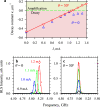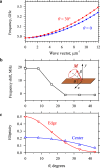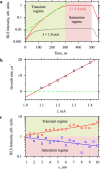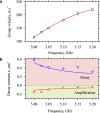True amplification of spin waves in magnonic nano-waveguides
- PMID: 38378662
- PMCID: PMC10879122
- DOI: 10.1038/s41467-024-45783-1
True amplification of spin waves in magnonic nano-waveguides
Abstract
Magnonic nano-devices exploit magnons - quanta of spin waves - to transmit and process information within a single integrated platform that has the potential to outperform traditional semiconductor-based electronics. The main missing cornerstone of this information nanotechnology is an efficient scheme for the amplification of propagating spin waves. The recent discovery of spin-orbit torque provided an elegant mechanism for propagation losses compensation. While partial compensation of the spin-wave losses has been achieved, true amplification - the exponential increase in the spin-wave intensity during propagation - has so far remained elusive. Here we evidence the operating conditions to achieve unambiguous amplification using clocked nanoseconds-long spin-orbit torque pulses in magnonic nano-waveguides, where the effective magnetization has been engineered to be close to zero to suppress the detrimental magnon scattering. We achieve an exponential increase in the intensity of propagating spin waves up to 500% at a propagation distance of several micrometers.
© 2024. The Author(s).
Conflict of interest statement
The authors declare no competing interests.
Figures







References
-
- Neusser S, Grundler D. Magnonics: Spin waves on the nanoscale. Adv. Mater. 2009;21:2927–2932. doi: 10.1002/adma.200900809. - DOI
-
- Lenk B, Ulrichs H, Garbs F, Münzenberg M. The building blocks of magnonics. Phys. Rep. 2011;507:107–136. doi: 10.1016/j.physrep.2011.06.003. - DOI
-
- Chumak A, Vasyuchka V, Serga A, Hillebrands B. Magnon spintronics. Nat. Phys. 2015;11:453–461. doi: 10.1038/nphys3347. - DOI
Grants and funding
LinkOut - more resources
Full Text Sources

